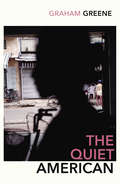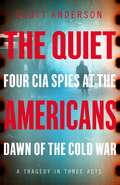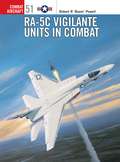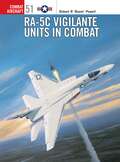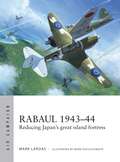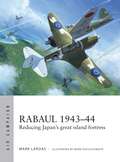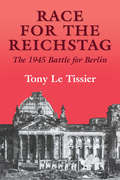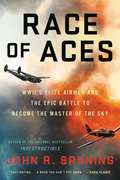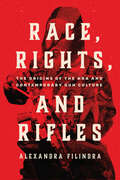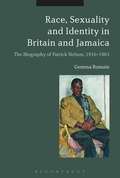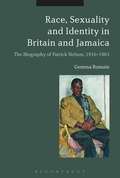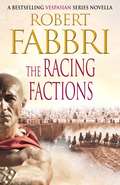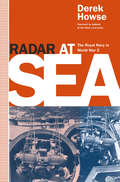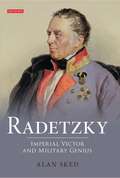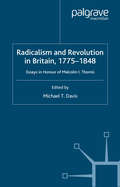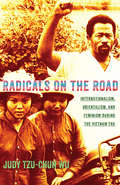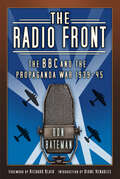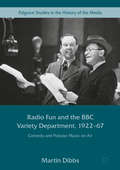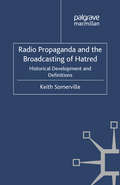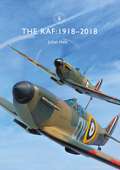- Table View
- List View
The Quiet American: Discover Graham Green’s prescient political masterpiece (Virago Modern Classics #Vol. 11)
by Graham GreeneWITH AN INTRODUCTION BY ZADIE SMITHInto the intrigue and violence of Indo-China comes Pyle, a young idealistic American sent to promote democracy through a mysterious 'Third Force'. As his naive optimism starts to cause bloodshed, his friend Fowler, a cynical foreign correspondent, finds it hard to stand aside and watch. But even as he intervenes he wonders why: for the sake of politics, or for love?
The Quiet Americans: Four CIA Spies at the Dawn of the Cold War - A Tragedy in Three Acts
by Scott Anderson‘A darkly entertaining tale about American espionage, set in an era when Washington’s fear and skepticism about the agency resembles our climate today.’ New York Times At the end of World War II, the United States dominated the world militarily, economically, and in moral standing – seen as the victor over tyranny and a champion of freedom. But it was clear – to some – that the Soviet Union was already executing a plan to expand and foment revolution around the world. The American government’s strategy in response relied on the secret efforts of a newly-formed CIA. The Quiet Americans chronicles the exploits of four spies – Michael Burke, a charming former football star fallen on hard times, Frank Wisner, the scion of a wealthy Southern family, Peter Sichel, a sophisticated German Jew who escaped the Nazis, and Edward Lansdale, a brilliant ad executive. The four ran covert operations across the globe, trying to outwit the ruthless KGB in Berlin, parachuting commandos into Eastern Europe, plotting coups, and directing wars against Communist insurgents in Asia. But time and again their efforts went awry, thwarted by a combination of stupidity and ideological rigidity at the highest levels of the government – and more profoundly, the decision to abandon American ideals. By the mid-1950s, the Soviet Union had a stranglehold on Eastern Europe, the US had begun its disastrous intervention in Vietnam, and America, the beacon of democracy, was overthrowing democratically elected governments and earning the hatred of much of the world. All of this culminated in an act of betrayal and cowardice that would lock the Cold War into place for decades to come. Anderson brings to the telling of this story all the narrative brio, deep research, sceptical eye, and lively prose that made Lawrence in Arabia a major international bestseller. The intertwined lives of these men began in a common purpose of defending freedom, but the ravages of the Cold War led them to different fates. Two would quit the CIA in despair, stricken by the moral compromises they had to make; one became the archetype of the duplicitous and destructive American spy; and one would be so heartbroken he would take his own life. Scott Anderson’s The Quiet Americans is the story of these four men. It is also the story of how the United States, at the very pinnacle of its power, managed to permanently damage its moral standing in the world.
RA-5C Vigilante Units in Combat (Combat Aircraft)
by Jim Laurier Robert R PowellDeveloped from the A-5 nuclear bomber and used in a reconnaissance role, the RA-5C Vigilante was the largest and fastest aeroplane ever to operate from the deck of an aircraft carrier. During the Vietnam War it sustained the highest loss ratio of any American aircraft in that conflict. This volume includes compelling accounts of combat missions over key communist targets, where crews dodged Surface-to-Air Missiles (SAMs) and anti-aircraft fire to secure all-important mission photographs. Written by a Vigilante combat veteran this book is crammed full of action-packed first-hand accounts.
RA-5C Vigilante Units in Combat (Combat Aircraft)
by Robert R PowellDeveloped from the A-5 nuclear bomber and used in a reconnaissance role, the RA-5C Vigilante was the largest and fastest aeroplane ever to operate from the deck of an aircraft carrier. During the Vietnam War it sustained the highest loss ratio of any American aircraft in that conflict. This volume includes compelling accounts of combat missions over key communist targets, where crews dodged Surface-to-Air Missiles (SAMs) and anti-aircraft fire to secure all-important mission photographs. Written by a Vigilante combat veteran this book is crammed full of action-packed first-hand accounts.
Rabaul 1943-44: Reducing Japan's Great Island Fortress (Air Campaign Ser. #2)
by Mark LardasIn 1942, the massive Japanese naval base and airfield at Rabaul was a fortress standing in the Allies' path to Tokyo. It was impossible to seize Rabaul, or starve the 100,000-strong garrison out. Instead the US began an innovative, hard-fought two-year air campaign to draw its teeth, and allow them to bypass the island completely. The struggle decided more than the fate of Rabaul. If successful, the Allies would demonstrate a new form of warfare, where air power, with a judicious use of naval and land forces, would eliminate the need to occupy a ground objective in order to control it. As it turned out, the Siege of Rabaul proved to be more just than a successful demonstration of air power – it provided the roadmap for the rest of World War II in the Pacific.
Rabaul 1943–44: Reducing Japan's great island fortress (Air Campaign #2)
by Mark Lardas Mark PostlethwaiteIn 1942, the massive Japanese naval base and airfield at Rabaul was a fortress standing in the Allies' path to Tokyo. It was impossible to seize Rabaul, or starve the 100,000-strong garrison out. Instead the US began an innovative, hard-fought two-year air campaign to draw its teeth, and allow them to bypass the island completely. The struggle decided more than the fate of Rabaul. If successful, the Allies would demonstrate a new form of warfare, where air power, with a judicious use of naval and land forces, would eliminate the need to occupy a ground objective in order to control it. As it turned out, the Siege of Rabaul proved to be more just than a successful demonstration of air power – it provided the roadmap for the rest of World War II in the Pacific.
Race for the Reichstag: The 1945 Battle for Berlin (Soviet (Russian) Military Experience #No. 4)
by Tony, Le Tissier MBEThe soldiers of the Red Army identified the Reichstag as the victor's prize to be taken in Berlin. This account of the battle lays the many myths created by Soviet propaganda after the event to rest and details what exactly happened as the Red Army and the Allies raced to be the first at the Reichstag.
Race for the Reichstag: The 1945 Battle for Berlin (Soviet (Russian) Military Experience)
by Tony, Le Tissier MBEThe soldiers of the Red Army identified the Reichstag as the victor's prize to be taken in Berlin. This account of the battle lays the many myths created by Soviet propaganda after the event to rest and details what exactly happened as the Red Army and the Allies raced to be the first at the Reichstag.
Race of Aces: WWII's Elite Airmen and the Epic Battle to Become the Master of the Sky
by John R Bruning"Brings you into the cockpit of the lethal, fast-paced world of fighter pilots...Fascinating." -- Sara Vladic"Extraordinary...A must-read." -- US Navy Captain Dan Pedersen"A heart-pounding narrative of the courage, sacrifice, and tragedy of America's elite fighter pilots." -- James M. Scott"Vivid and gripping...Confirms Bruning's status as the premier war historian of the air." -- Saul DavidThe astonishing untold story of the WWII airmen who risked it all in the deadly race to become the greatest American fighter pilot. In 1942, America's deadliest fighter pilot, or "ace of aces" -- the legendary Eddie Rickenbacker -- offered a bottle of bourbon to the first U.S. fighter pilot to break his record of twenty-six enemy planes shot down. Seizing on the challenge to motivate his men, General George Kenney promoted what they would come to call the "race of aces" as a way of boosting the spirits of his war-weary command. What developed was a wild three-year sprint for fame and glory, and the chance to be called America's greatest fighter pilot. The story has never been told until now. Based on new research and full of revelations, John Bruning's brilliant, original book tells the story of how five American pilots contended for personal glory in the Pacific while leading Kenney's resurgent air force against the most formidable enemy America ever faced. The pilots -- Richard Bong, Tommy McGuire, Neel Kearby, Charles MacDonald and Gerald Johnson -- riveted the nation as they contended for Rickenbacker's crown. As their scores mounted, they transformed themselves from farm boys and aspiring dentists into artists of the modern dogfight. But as the race reached its climax, some of the pilots began to see how the spotlight warped their sense of duty. They emerged as leaders, beloved by their men as they chose selfless devotion over national accolades. Teeming with action all across the vast Pacific theater, Race of Aces is a fascinating exploration of the boundary between honorable duty, personal glory, and the complex landscape of the human heart.
Race, Rights, and Rifles: The Origins of the NRA and Contemporary Gun Culture (Chicago Studies in American Politics)
by Alexandra FilindraAn eye-opening examination of the ties between American gun culture and white male supremacy from the American Revolution to today. One-third of American adults—approximately 86 million people—own firearms. This is not just for protection or hunting. Although many associate gun-centric ideology with individualist and libertarian traditions in American political culture, Race, Rights, and Rifles shows that it rests on an equally old but different foundation. Instead, Alexandra Frilindra shows that American gun culture can be traced back to the American Revolution when republican notions of civic duty were fused with a belief in white male supremacy and a commitment to maintaining racial and gender hierarchies. Drawing on wide-ranging historical and contemporary evidence, Race, Rights, and Rifles traces how this ideology emerged during the Revolution and became embedded in America’s institutions, from state militias to the National Rifle Association (NRA). Utilizing original survey data, Filindra reveals how many White Americans —including those outside of the NRA’s direct orbit—embrace these beliefs, and as a result, they are more likely than other Americans to value gun rights over voting rights, embrace antidemocratic norms, and justify political violence.
Race, Sexuality and Identity in Britain and Jamaica: The Biography of Patrick Nelson, 1916-1963
by Gemma RomainThis is the first biography of the extraordinary, but ordinary life of, Patrick Nelson. His experiences touched on some of the most important and intriguing historical themes of the twentieth century. He was a black migrant to interwar Britain; an aristocrat's valet in rural Wales; a Black queer man in 1930s London; an artist's model; a law student, a recruit to the Auxiliary Military Pioneer Corps and Prisoner of War during the Second World War. Through his return to Jamaica after the war and his re-migrations to London in the late 1940s and the early 1960s, he was also witness to post-war Jamaican struggles and the independence movement as well as the development of London's post-war multi-ethnic migrations. Drawing on a range of archival materials including letters sent to individuals such as Bloomsbury group artist Duncan Grant (his former boyfriend and life-long friend), as well as paintings and newspaper articles, Gemma Romain explores the intersections of these diverse aspects of Nelson's life and demonstrates how such marginalized histories shed light on our understanding of broader historical themes such as Black LGBTQ history, Black British history in relation to the London artworld, the history of the Second World War, and histories of racism, colonialism and empire.
Race, Sexuality and Identity in Britain and Jamaica: The Biography of Patrick Nelson, 1916-1963
by Gemma RomainThis is the first biography of the extraordinary, but ordinary life of, Patrick Nelson. His experiences touched on some of the most important and intriguing historical themes of the twentieth century. He was a black migrant to interwar Britain; an aristocrat's valet in rural Wales; a Black queer man in 1930s London; an artist's model; a law student, a recruit to the Auxiliary Military Pioneer Corps and Prisoner of War during the Second World War. Through his return to Jamaica after the war and his re-migrations to London in the late 1940s and the early 1960s, he was also witness to post-war Jamaican struggles and the independence movement as well as the development of London's post-war multi-ethnic migrations. Drawing on a range of archival materials including letters sent to individuals such as Bloomsbury group artist Duncan Grant (his former boyfriend and life-long friend), as well as paintings and newspaper articles, Gemma Romain explores the intersections of these diverse aspects of Nelson's life and demonstrates how such marginalized histories shed light on our understanding of broader historical themes such as Black LGBTQ history, Black British history in relation to the London artworld, the history of the Second World War, and histories of racism, colonialism and empire.
The Racing Factions: A Crossroads Brotherhood Novella from the bestselling author of the VESPASIAN series (A Crossroads Brotherhood Novella #1)
by Robert FabbriAn ebook-exclusive short story from the bestselling Vespasian series.Marcus Salvius Magnus is a fanatical supporter of the Green Racing Faction and expects a wager to be honoured. Although he does not presume honesty from anyone, he does believe that a bookmaker at the Circus Maximus should record each bet scrupulously and pay the full amount due. But Ignatius, the bookmaker, is foolish enough to attempt to cheat Magnus out of his winnings, incurring not only his wrath but that also of the South Quirinal Crossroads Brotherhood of which Magnus is the leader. In the shady realm of Rome's underworld Magnus will use the full resources of his criminal fraternity to exact appropriate vengeance.But Magnus also has a problem: his patron, Gaius Vespasius Pollo, is attempting to get his nephew, Sabinus, elected as a quaestor. To do this he feels that the support of the senior consul, Gnaeus Domitius Ahenobarbus, would be more than useful. He asks Magnus to ease the consul - a man known for his extreme violence - in the right direction.Ahenobarbus has a passion: the Red Faction at the circus. Could it be that Magnus might wash two tunics in the same tub, bringing Ignatius down and securing Ahenobarbus' support by attempting to fix a chariot race in a manner that has never been done before?
Racing the Enemy: Stalin, Truman, and the Surrender of Japan
by Tsuyoshi HasegawaWith startling revelations, Tsuyoshi Hasegawa rewrites the standard history of the end of World War II in the Pacific. By fully integrating the three key actors in the story--the United States, the Soviet Union, and Japan--Hasegawa for the first time puts the last months of the war into international perspective. From April 1945, when Stalin broke the Soviet-Japanese Neutrality Pact and Harry Truman assumed the presidency, to the final Soviet military actions against Japan, Hasegawa brings to light the real reasons Japan surrendered. From Washington to Moscow to Tokyo and back again, he shows us a high-stakes diplomatic game as Truman and Stalin sought to outmaneuver each other in forcing Japan's surrender; as Stalin dangled mediation offers to Japan while secretly preparing to fight in the Pacific; as Tokyo peace advocates desperately tried to stave off a war party determined to mount a last-ditch defense; and as the Americans struggled to balance their competing interests of ending the war with Japan and preventing the Soviets from expanding into the Pacific. Authoritative and engrossing, Racing the Enemy puts the final days of World War II into a whole new light.
Radar at Sea: The Royal Navy in World War 2
by Derek HowseThis book tells in non-technical language how the British Navy contributed to the development of naval radar in World War 2. Addressed to the general reader, it tells not only the technical story in simple terms, but also of the operational use of shipborne radar at sea - for warning, for fire control, for fighter direction, for navigation, in all theatres of war - and particularly about the people who designed and fitted the equipment, and those who used it at sea.
Radetzky: Imperial Victor and Military Genius
by Alan SkedHistory remembers Wellington's defeat of Napoleon, but has forgotten the role of Field Marshal Radetzky in the battles which led to Napoleon's abdication and first exile in 1814. As Chief of Staff to the allied coalition of 1813-14, Radetzky determined the shape of the most decisive campaigns of the Napoleonic Wars by creating the strategy that defeated the Corsican in Germany and then France. Neither Russia nor Prussia had been able to overcome Napoleon in battle and it took the brilliant diplomacy of Metternich and the military genius of Radetzky to ensure victory over the Emperor. In short, the Austrian contribution decisively tipped the balance against Napoleon - a fact which has always been overlooked by historians. It was Radetzky, too, at the age of eighty-two, who defeated the Italians in 1848 and 1849 and thus saved Europe once again from the prospect of international war and revolution. The wars Radetzky fought - and won - throughout his extensive military career were of the greatest possible significance in European history, yet today, he is almost forgotten - remembered only in the music of the Radetzky March, dedicated to him by Johann Strauss the elder.In this, the first biography of Radetzky to be published in English, Alan Sked paints a vivid picture of an exceptional, yet neglected commander of genius in a book which will be fascinating reading for enthusiasts of military and modern European history.
Radetzky: Imperial Victor and Military Genius
by Alan SkedHistory remembers Wellington's defeat of Napoleon, but has forgotten the role of Field Marshal Radetzky in the battles which led to Napoleon's abdication and first exile in 1814. As Chief of Staff to the Allied Coalition of 1813-1814, Field Marshal Count Joseph Radetzky von Radetz determined the shape of the most decisive campaigns of the Napoleonic wars by inventing the strategy that in a matter of months defeated Napoleon. Neither Russia nor Prussia had been able to overcome the Corsican in battle and the forces that these powers controlled between them in 1813 were in no position to challenge him in Europe. It took the brilliant diplomacy of Metternich and the military genius of Radetzky to ensure victory over the Emperor. In short, the Austrian contribution decisively tipped the balance against Napoleon - a fact which has always been overlooked by historians. Later in Radetzky's career, in 1848 and again in 1849, it was he who defeated a much superior army not merely to maintain the political and geographical integrity of the Habsburg Monarchy but thereby almost certainly preventing a whole continent from dissolving once again into war and revolution as it had in 1792-1815.Yet, despite his impressive military record, Radetzky was not simply a commander. He was also an important military thinker, who examined all the key issues of his day - not merely strategy and tactics but also fortifications, the role of a general staff, the role of horses in warfare, the need for technical corps amongst many other issues. He was also progressive politically: he believed in moving with the times, in constitutionalism and in popular defence and was active in military strategy until his retirement, at the age of 90, in 1857.Radetzky's achievements on the battlefield were of the greatest possible significance in European history, yet today, Radetzky is almost forgotten - remembered only in the music of the Radetzky March, dedicated to him by Johann Strauss the elder. In this, the first biography of Radetzky in English, Alan Sked paints a vivid picture of an exceptional, yet neglected, military commander in a book which will be fascinating reading for enthusiasts of military and modern European history.
Radical: My Journey from Islamist Extremism to a Democratic Awakening
by Maajid NawazBorn and raised in Essex, Maajid Nawaz was recruited into politicised Islam as a teenager. Abandoning his love of hip hop music, graffiti and girls, he was recruited into Hizb ut-Tahrir (the Liberation Party) where he played a leading and international role in the shaping and dissemination of an aggressive anti-West narrative. While studying for his Arabic and law degree, he travelled around the UK and to Denmark and Pakistan, setting up new cells.Arriving in Egypt the day before 9/11 his views soon led to his arrest, imprisonment and mental torture, before being thrown into solitary confinement in a Cairo jail reserved for political prisoners. There, while mixing with everyone from the assassins of Egypt's president to Liberal reformists, he underwent an intellectual transformation and on his release after four years, he publically renounced the Islamist ideology that had defined his life. This move would cost him his marriage, his family and his friends as well as his own personal security.Six years after his release, Maajid now works all over the world to counter Islamism and to promote democratic ideals through his organisation, The Quilliam Foundation, which he co-founded with former Islamist and bestselling author Ed Husain.Following in the wake of the extraordinary democratic change in the Arab world, that few would have foretold, Radical is Maajid's intensely personal account of life inside and out of Islamic extremism. It also highlights one man's quest to inspire change and challenge extremism in all its forms.This is a hard-hitting memoir of one man's journey into and out of Islamic extremism.
Radical Sacrifice: The Rise and Ruin of Fitz John Porter (Civil War America)
by William MarvelBorn into a distinguished military family, Fitz John Porter (1822-1901) was educated at West Point and breveted for bravery in the war with Mexico. Already a well-respected officer at the outset of the Civil War, as a general in the Union army he became a favorite of George B. McClellan, who chose him to command the Fifth Corps of the Army of the Potomac. Porter and his troops fought heroically and well at Gaines's Mill and Malvern Hill. His devotion to the Union cause seemed unquestionable until fellow Union generals John Pope and Irvin McDowell blamed him for their own battlefield failures at Second Bull Run. As a confidant of the Democrat and limited-war proponent McClellan, Porter found himself targeted by Radical Republicans intent on turning the conflict to the cause of emancipation. He made the perfect scapegoat, and a court-martial packed with compliant officers dismissed him for disobedience of orders and misconduct before the enemy. Porter tenaciously pursued vindication after the war, and in 1879 an army commission finally reviewed his case, completely exonerating him. Obstinately partisan resistance from old Republican enemies still denied him even nominal reinstatement for six more years. This revealing new biography by William Marvel cuts through received wisdom to show Fitz John Porter as he was: a respected commander whose distinguished career was ruined by political machinations within Lincoln's administration. Marvel lifts the cloud that shadowed Porter over the last four decades of his life, exposing the spiteful Radical Republicans who refused to restore his rank long after his exoneration and never restored his benefits. Reexamining the relevant primary evidence from the full arc of Porter's life and career, Marvel offers significant insights into the intersections of politics, war, and memory.
Radicalism and Revolution in Britain 1775-1848: Essays in Honour of Malcolm I. Thomis
by M. DavisThe spectre of revolution and the nature of radicalism in Britain from the late eighteenth century through to the age of the Chartists has for some time engaged the interest of scholars and been the topic of much debate. This book honours one of the subject's most renowned and respected historians, Professor Malcolm I. Thomis. In a collection distinguished by its formidable range of contributors, a series of stimulating essays explores and re-examines the threats and ideas of revolution and the byzantine networks and character of British radical culture in the turbulent and intriguing years between 1775 and 1848.
Radicals on the Road: Internationalism, Orientalism, and Feminism during the Vietnam Era (The United States in the World)
by Judy Tzu-Chun WuTraveling to Hanoi during the U.S. war in Vietnam was a long and dangerous undertaking. Even though a neutral commission operated the flights, the possibility of being shot down by bombers in the air and antiaircraft guns on the ground was very real. American travelers recalled landing in blackout conditions, without lights even for the runway, and upon their arrival seeking refuge immediately in bomb shelters. Despite these dangers, they felt compelled to journey to a land at war with their own country, believing that these efforts could change the political imaginaries of other members of the American citizenry and even alter U.S. policies in Southeast Asia. In Radicals on the Road, Judy Tzu-Chun Wu tells the story of international journeys made by significant yet underrecognized historical figures such as African American leaders Robert Browne, Eldridge Cleaver, and Elaine Brown; Asian American radicals Alex Hing and Pat Sumi; Chicana activist Betita Martinez; as well as women’s peace and liberation advocates Cora Weiss and Charlotte Bunch. These men and women of varying ages, races, sexual identities, class backgrounds, and religious faiths held diverse political views. Nevertheless, they all believed that the U.S. war in Vietnam was immoral and unjustified. In times of military conflict, heightened nationalism is the norm. Powerful institutions, like the government and the media, work together to promote a culture of hyperpatriotism. Some Americans, though, questioned their expected obligations and instead imagined themselves as "internationalists," as members of communities that transcended national boundaries. Their Asian political collaborators, who included Buddhist monk Thich Nhat Hanh, Foreign Minister of the Provisional Revolutionary Government Nguyen Thi Binh and the Vietnam Women’s Union, cultivated relationships with U.S. travelers. These partners from the East and the West worked together to foster what Wu describes as a politically radical orientalist sensibility. By focusing on the travels of individuals who saw themselves as part of an international community of antiwar activists, Wu analyzes how actual interactions among people from several nations inspired transnational identities and multiracial coalitions and challenged the political commitments and personal relationships of individual activists.
The Radio Front: The BBC and the Propaganda War 1939-45
by Ron BatemanWithin seventeen years of the first public broadcast in Britain, the nation again found itself at war. As the Second World War progressed, the BBC eventually realised the potential benefits of public radio and the service became vital in keeping an anxious public informed, upbeat and entertained behind the curtains of millions of blacked-out homes. The Radio Front examines just how the BBC reinvented itself and delivered its carefully controlled propaganda to listeners in the UK and throughout Nazi-occupied Europe. It also reveals the BBC’s often-strained relationships with the government, military and public as the organisation sought to influence opinion and safeguard public morale without damaging its growing reputation for objectivity and veracity.Using original source material, historian and author Ron Bateman tracks the BBC’s growth during the Second World War from its unorganised and humble beginnings to the development of a huge overseas and European operation, and also evaluates the importance of iconic broadcasts from the likes of J.B. Priestley, Vera Lynn and Tommy Handley.
Radio Fun and the BBC Variety Department, 1922-67: Comedy and Popular Music on Air (Palgrave Studies in the History of the Media)
by Martin DibbsThis book provides a narrative history of the BBC Radio Variety Department exploring, along chronological lines, the workings of, tensions within and the impact of BBC policies on the programme-making department which generated the organisation’s largest audiences. It provides an insight into key events, personalities, programmes, internal politics and trends in popular entertainment, censorship and anti-American policy as they individually or collectively affected the Department. Martin Dibbs examines how the Department's programmes became markers in the daily and weekly lives of millions of listeners, and helped shape the nation's listening habits when radio was the dominant source of domestic entertainment. The book explores events and topics which, while not directly forming part of the Variety Department’s history, nevertheless intersected with or had an impact on it. Such topics include the BBC’s attitude to jazz and rock and roll, the arrival of television with its impact on radio, the pirate radio stations, and the Popular Music and Gramophone Departments, both of whom worked closely with the Variety Department.
Radio Propaganda and the Broadcasting of Hatred: Historical Development and Definitions
by K. SomervilleAn exposition and analysis of the development of propaganda, focusing on how the development of radio transformed the delivery and impact of propaganda and led to the use of radio to incite hatred and violence.
The RAF: 1918–2018 (Shire Library)
by Julian HaleFor a hundred years the Royal Air Force has been at the forefront of the UK's defences. In the 1920s and 1930s, the RAF protected Britain's empire; during the Second World War it played a key role in defeating the Axis; and through the 1950s and 1960s it was a key part of Britain's nuclear deterrent. Julian Hale examines the history of the RAF through its organisation, personnel, aircraft and campaigns, from the biplanes of the First World War, through its 'Finest Hour' in 1940 and the dawn of the jet age to today's hi-tech aircraft and the emerging role of the unmanned aerial vehicle. Enriched with personal accounts and a wealth of photographs, this book provides a concise introduction to the world's first air force.
